In the same way that rashes, coughs, and fevers are the symptoms of a human sickness, water stains and soft spots are the harbingers of a leaking RV roof. If you learn what to look for, you can diagnose a failing RV roof before it brings the rest of your RV down with it.
Unfortunately, for many RVs this is a question of when, not if. Most travel trailers, 5th wheels, Class A’s, and Class C’s are covered with a membrane roof. Choices of membrane include EPDM, PVC, and TPO, but are all made of a thin plastic sheet no thicker than a dime! It only takes a single puncture or tear to rip through the membrane and expose the raw, vulnerable OSB underneath.
Let’s consider a few common signs of an RV roof leak. To borrow an old phrase, “Knowledge is power; knowledge shared is power multiplied.”
Signs of an RV Roof Leak: What You See On Top
You should always start an RV roof inspection by looking at the RV roof itself! Unfortunately, by the time a roof leak has manifested itself from the interior, it’s often too late. The roof is already full of moisture and mold. You’ll need a full tear-off to restore your RV to like-new condition.
1. Raised Sheeting Edges
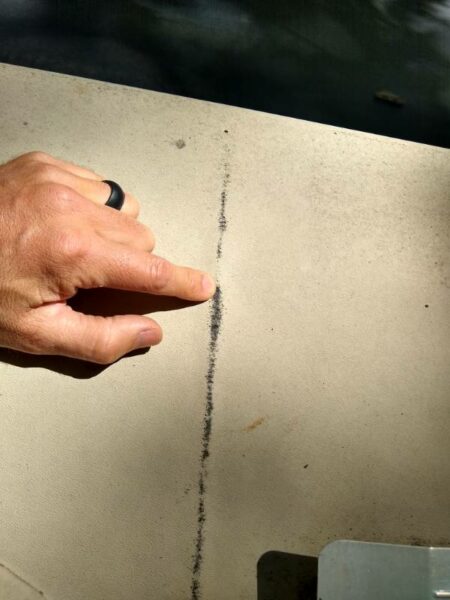
If your roof springs a leak, the underlying roof decking – usually OSB or plywood – will swell when wet. This is often most evident at the seams, where a swollen edge will telegraph through the flexible membrane. If you see swollen or staggered seams at the decking joints, that’s a strong indicator that the roof decking is or has gotten wet. Typically, the decking joints will be spaced 48” on center. If you have a wide-body RV, you may have also end-to-end butt joints along one side of your roof, spaced about 4-6” from the sidewall.
2. Cracked or Flaking Sealant
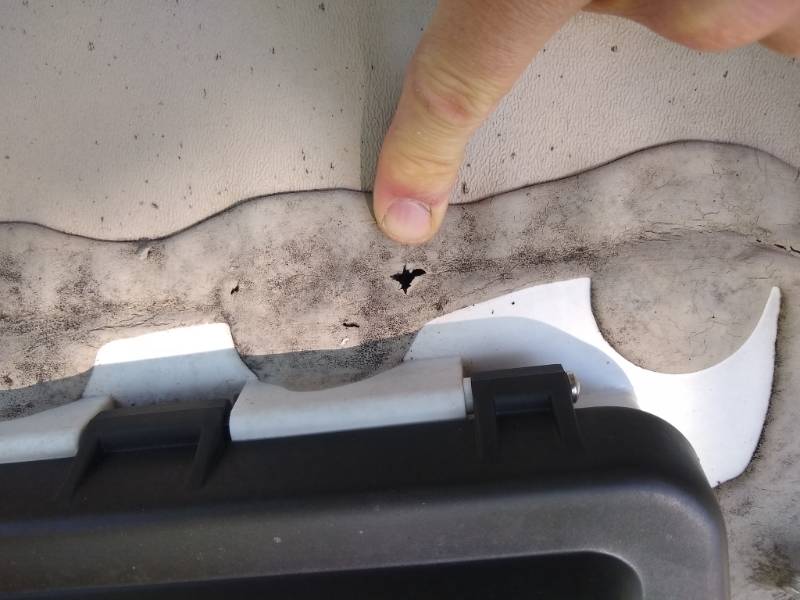
I’ve already written several articles on maintaining and inspecting your roof sealants, so I won’t rehash that advice here. Suffice it to say that anywhere the sealant is loose, peeling, flaking, cracking, or otherwise damaged is prime real estate for a roof leak. Typical places to look include pipe caps, antennae, trim and moulding, and skylights.
3. Soft Spots On the Roof
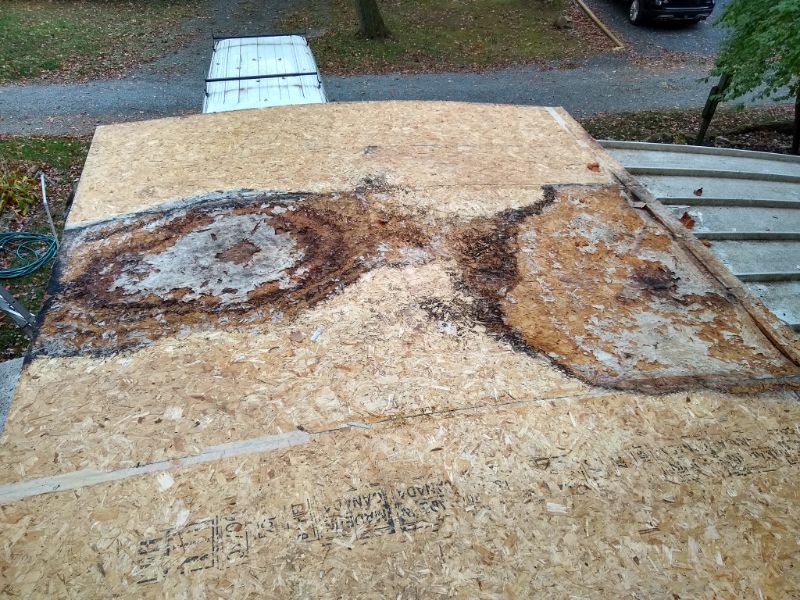
When wood gets wet, then dry, then wet, then dry, the fibers will slowly disintegrate. This will weaken the OSB or plywood decking, resulting in soft spots in the your roof. By carefully walking around your roof, or even crawling on your hands and knees, you can find these soft spots before they grow into an outrageous size. Typical places to look include the front and rear corners and around skylights and ceiling fans. These softs can feel soft, spongy, mushy, or even completely disintegrate with a slight poke of your finger!
4. Delaminated Roofing
RV membrane roofing is adhered to the decking with an weak glue adhesive (usually waterborne). If you’ve ever installed flooring, this is similar to a sheet vinyl flooring adhesive. Anyway, water egress will break these chemical bonds. Your rubber roof will delaminate, which can cause bubbling, flapping, or stretching, especially when driving as wind will be driven into the airspace.
>>> READ MORE: Old, Decrepit RV Roof? 5 Options for Repair!
Signs of an RV Roof Leak: What You See From Within
5. Water Stains on the Ceiling or Walls
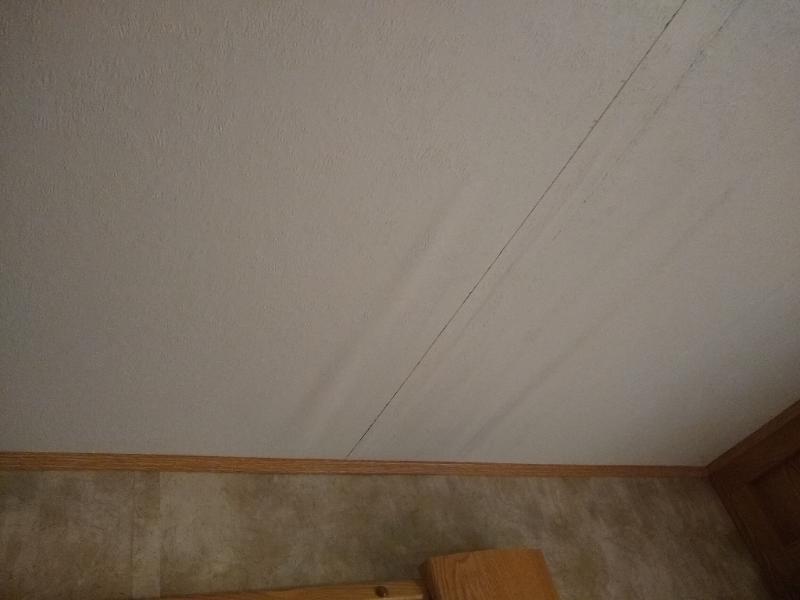
This is probably the most common spot for an RV roof leak. These stains can be any color: brown, black, yellow, etc. Inspect the entire roof, not just the sections you can easily see. Open up cabinets, and check the corners. By the time water has leaked onto your ceiling panels, it’s likely that some part of your RV roof structure is already drenched and possibly damaged.
On the walls, water stains will typically show up as streaks. The same rules apply. And don’t assume the water stain is close to the source! Water can easily run half the length of an RV before it decides to show its face. You just never can tell.
Unfortunately, not all water stains on the ceiling are caused by roof leaks. Condensation from leaky air conditioning ducts can mimic a slow, trickling water leak. Sometimes, condensation from an air conditioner’s evaporator coils will wick or dribble inside the distribution plenum, which can also mimic a roof leak. These are problems, certainly, but water isn’t coming from outside your roof; it’s common for condensation not staying where it’s supposed to!
6. Dripping Roof Components
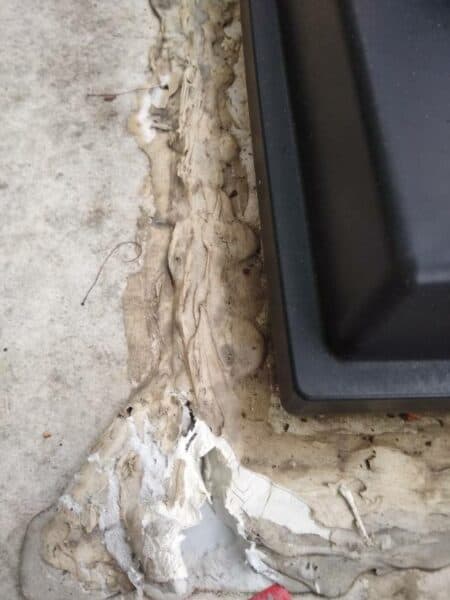
If you notice water dripping from any of your roof penetrations – skylights, air conditioners, roof vents, plumbing vents – then bust out the flashlight and a ladder! These components can be damaged from highway overpasses, overhanging trees, and low garage doors. Before assuming that the membrane itself is damaged, check if the skylight or vent cover itself is damaged. If so, replace.
7. Soft Spots On Your Floor
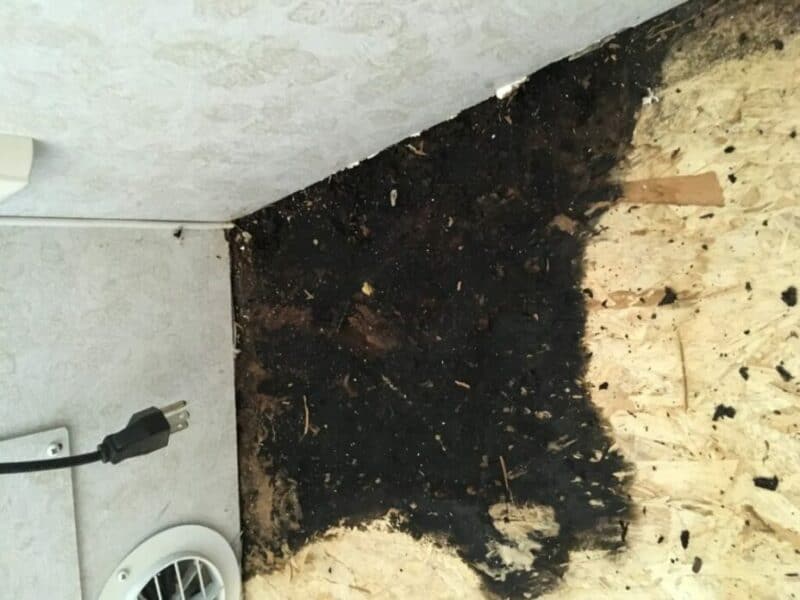
When wood gets wet, then dry, then wet, then dry, the fibers will slowly disintegrate. This will weaken the OSB or plywood decking, resulting in soft spots in your subfloor. By carefully walking around your roof, or even crawling on your hands and knees, you can find these soft spots before they grow into an outrageous size.
Here’s the problem with a soft spot in your floor … it’s highly unlikely the soft spot is at the point of water intrusion. It’s far, far more likely that you have a leaky pipe or leaky roof, and the water has saturated much of the rest of your RV. Sometimes, it is worth replacing the damaged subfloor and tracking down the root cause (especially if the leak is confined to a slide-out). Other times, it’s best to recite the last rites over your RV and use it until it falls apart (or becomes a hunting cabin).
8. Mold or Mildew On the Interior Surfaces
Mold is generally black, brown, or green; mildew is usually white. Both require moisture and heat to grow. If your RV is growing mold or mildew on the interior surfaces, despite your efforts with a dehumidifier or DampRid, then you should consider the possibility of a roof leak. A leaky roof will often become saturated with water, which humidifies the air in the RV attic. This water vapor disperses into the RV itself, humidifying the interior air as well. If you see mold growing in corners or behind cabinets, that’s a sign that a water leak may be the culprit.
How Do I Find a Leak on My Roof?
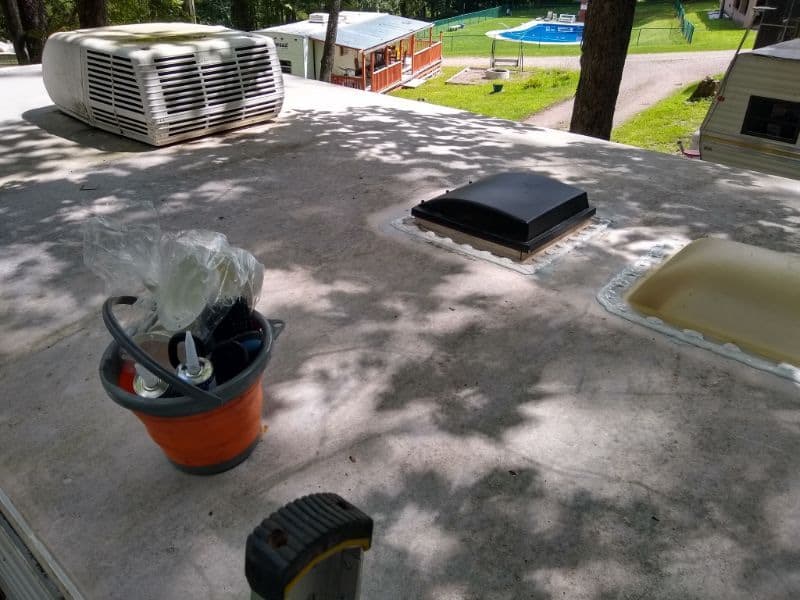
If you suspect a water leak from a failed RV roof, the next step is to confirm your diagnosis. There are three basic methods:
- Visual inspection. A flashlight and 20/20 vision can tell you a lot! You have to get down on your hands and knees to properly inspect an RV roof, though. Use all five senses: Tap to listen for the sound of the underlayment. Stomp to feel the solidness of the roof structure. Look for tiny tears or pinholes. Recognize the odor of mold and decay.
- Hose test: Some roof leaks will reappear with a rain test. You can mimic the effect of a strong storm with a simple garden sprayer. Might as well add soap and clean your roof while you’re at it.
- Pressure test. If all your efforts are coming up empty, you can take your RV to a service center and ask for a pressurized Seal-Tech test. In this test, your RV is sprayed with soapy water, and the inside is pressurized with an air pump. Any air that escapes out the RV sidewalls or roof will show up as soap bubbles.
Leave a Reply